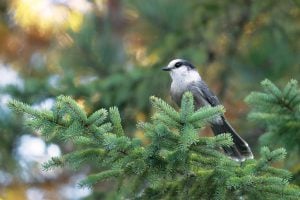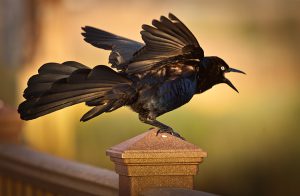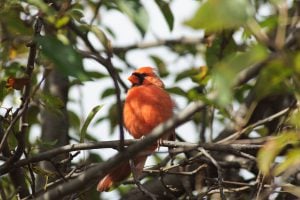
Wildlife
Excerpt from The Canada Jay as the National Bird of Canada
Editor-in-chief and associate publisher Aaron Kylie contributed this chapter to a compilation book about the Canada Jay
- 1532 words
- 7 minutes
This article is over 5 years old and may contain outdated information.
Wildlife

Birds are attractive, captivating, ubiquitous and uniquely suited to connect people with the natural world. Birding is wonderfully addictive — the more you do it, the more you want to see and learn.
Birds have always been an important part of my life. But when I started out birding in my hometown of Peterborough, Ont., I had never heard of a Harris’s sparrow or Canada warbler. Does their relative obscurity mean they are not suited for the title of Canada’s National Bird?
It’s not surprising that some countries choose large, powerful and flamboyant species — such as the bald eagle or Andean condor — as their emblems. But there are also many national birds that are smaller and less conspicuous, such as the rufous-bellied Thrush (Brazil), the redwing (Turkey) and the barn swallow (Austria). As I write this essay, two songbirds (gray jay and black-capped chickadee) have received enough votes to reach Canada’s current top five. Common raven (our country’s largest songbird) is not far behind.
For me, one of the most exciting aspects of this competition to choose a national bird is the opportunity for people to learn more about the amazing variety of birds that call Canada home. Three species that I feel deserve a closer look are the Harris’s sparrow, Canada warbler, and dark-eyed junco. Harris’s sparrow
A true bird of the wilderness, this large and boldly-patterned sparrow can be found in the transition zone between the boreal forest and the low arctic tundra. Its breeding range stretches east from the Mackenzie River Delta to the northernmost section of Ontario — such a remote region that the Harris’s sparrow was one of the last North American songbirds to have its nest and eggs discovered. It winters throughout the central U.S. Great Plains region. Why consider the Harris’s sparrow for our national bird? It has the distinction of being Canada’s only endemic breeding songbird. This means it does not nest anywhere else in the world. Can’t get much more Canadian than that!
Canada warbler
Having Canada in its name makes this songbird a contender, and being strikingly beautiful helps too. Its breeding range runs from northeastern British Columbia across the southern boreal forest region to Nova Scotia, and also extends into southern Ontario, the northeastern U.S., and through the Appalachians. How Canadian is this species? About 80 per cent of all Canada warblers breed in Canada. The entire population winters in northern South America, primarily in the Andes. According to the Canadian Breeding Bird Survey, Canada warbler populations have declined significantly over the last 40 years (on average, 2.9 per cent per year since 1970). The species has been federally designated as Threatened since 2008. Reasons for population declines include changes in Canada’s boreal forests and habitat loss in wintering areas. Greater national pride in the Canada warbler and increased awareness of its plight could only benefit this bird in the long run.
Dark-eyed junco
The dark-eyed junco may not be an immediately obvious choice for Canada’s National Bird. But this attractive songbird can be found throughout the country. It breeds in Canada’s coniferous forests, and winters across southern Canada and the U.S. Unlike the Harris’s sparrow or the Canada warbler, the dark-eyed junco is one of our country’s most widespread and common forest birds. And it’s well known to the many people who feed birds each winter. The dark-eyed junco is one of the most frequently reported birds monitored through Bird Studies Canada’s Project FeederWatch, a North America-wide citizen science program. Choosing a familiar species as Canada’s national bird could offer several advantages. Inspiring citizens to pay a bit more attention to juncos and other backyard birds might be a good place to start for those of us who want to engage more people in bird appreciation and conservation!
I realize there is a good chance that popular species such as the common loon, snowy owl and Canada goose will garner the most votes through the National Bird Project. Personally, my goal is to draw attention to the wealth of options available, and the merits of some other candidates. If this is the first time you’ve ever heard about the Harris’s sparrow, then I’ve accomplished my mission! The National Bird Project provides a wonderful opportunity to raise awareness about Canada’s fascinating birds. It’s well worth taking the time to explore the full list of options, and learn more about great birds such as the spruce grouse, semi-palmated sandpiper, and pine grosbeak. My advice: get to know all of the candidates. You may discover a bird on this list that you’d like to see in the wild. To me, that would be the best outcome of all.
Jody Allair is a Biologist and Science Educator, Bird Studies Canada
Are you passionate about Canadian geography?
You can support Canadian Geographic in 3 ways:

Wildlife
Editor-in-chief and associate publisher Aaron Kylie contributed this chapter to a compilation book about the Canada Jay

Travel
Spread your wings with birdwatching’s elite guard in south Texas

Wildlife
Do you want one of these four birds to become Canada’s national bird?

Wildlife
You’ll be amazed at the feathered friends you can attract to your yard by following these simple tips